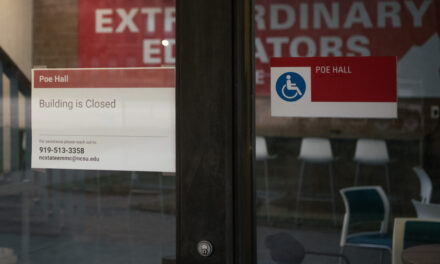The African American Cultural Center was the housing place, of a program titled, Beyond Borderlines, co-sponsored by the Society of Afrikan American Culture (SAAC) and Mi Familia. Mi Familia is a club on campus whose main purpose is “to provide a social, cultural, and political forum for the students of North Carolina State University and the surrounding community interested in experiencing and promoting the richness of the international Latino and Hispanic community and culture.” The Society of Afrikan American Culture serves as the political voice of the Black student body. Through political awareness, cultural affairs, and community service, SAAC aims to maintain the black identity and presence on campus.
The event Beyond Borderlines was held in a round table discussion form. Students discussed various topics during this program which affects that African American as well as the Latino community in today’s society. Each table had a specific topic that they had to talk about for approximately 10 to 15 minutes. The goal for was for each table mixed with African American, Latino, and many other ethnicities to get involved and put in as much effort to unite their opinions, thoughts, and expressions. The topics of discussion ranged from music in the Hispanic and Afro-American community, entertainment, and alliances that may lie between the Hispanic and African American community.
Racial harmony was a forerunning topic. Facilitators asked if there was a problem with racial connections between Hispanics and African Americans. Students gave mixed views on this issue ranging from students saying we have bridged a huge gap that was once presence amongst the Latino and African American communities. Others emphasized that even though this gap has been somewhat bridged that there still is more that can be done to further close the racial gap.
Stereotyping was a hot commodity during the open round table discussions. Students mentioned how immigrants are generally associated with the Latino community. Job opportunities are the same for people of all race, religion, creed, sex, and ethnicity. However, some individuals feel that certain jobs are beneath their working standards. Cultural affairs chair for the SAAC organization, Salena Wright, posed the question, “Is the Hispanic and Latino community preventing the black community from getting ahead?” This was another controversial topic that had mixed reactions. This is where the stereotype comes in to say that Hispanics are willing to do the less desirable jobs for a low pay which others such as African American and Caucasians will overlook. Students also discussed how Latino’s have a very strong support system from their families. Considering that Latinos are in the minority group such as African Americans are, they closely associate themselves with their friends and family.
A guest panel was also present at this event for an open question and answer session. The panel included Mr. Abraham Dones, assistant director for office of Hispanic/Native American Student Affairs in the Multicultural Student Affairs Office, who is Puerto Rican. His wife, Mrs. Toya Dones, who is African American, was also on the panel along with his daughter. The panel talked about the difficulties and struggles they face, being an interracial couple with a bi-racial child. When asked, how he felt other people view interracial relationships, Mr. Dones responded with saying he is “hoping that people look beyond race factors and learn to commit to love, marriage, and their children and not just race.” Mrs. Toya Dones was asked if the geographic location has anything to contribute to the response they get with being an interracial couple. She said that “location plays a lot into stereotypes of how people view others.” The Dones couple emphasized how they overlook the small things that people do and say to try to interfere with their strong relationship, and just focus on their marriage and their daughter. They both agreed that they the biggest problem is people’s ignorance and that they have to be willing to accept that unknown. Mr. Dones said that his daughter has “the best of both worlds which is Puerto Rican and African American, therefore, I call her Afro-marican.”
This event, Beyond Borderlines, was not only geared towards bridging the gap in the Latinos and African Americans it was also an eye-opener to the general public on how far things have come but yet how far they have to go. Mi Familia and SAAC executive board members said this was a successful event and other events will be planned in the near future in hopes of bridging the gap even more between both communities.


